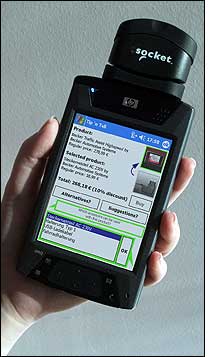A group of German researchers has developed a prototype mobile shopping assistant consisting of a PDA with a plug-in RFID interrogator to help customers and sales associates access instant information regarding products on store shelves and racks.
“We don’t want shoppers to just see the physical product. They should access a digital representation as well,” says Tobias Kowatsch, who is in charge of operations and empirical studies for the SmaProN project at the University of Furtwangen in Germany’s Black Forest. SmaProN stands for Smart Product Networks.
The system, dubbed Tip ‘n Tell, is designed to make any product a store sells interactive. Each product would carry a passive high-frequency (13.56 MHz) RFID tag, compliant with the ISO 15693 standard, on which a unique identification number is stored. A user can bring their PDA, outfitted with an RFID reader, close to the products that interest them. The interrogator reads each item’s tag and transmits the tag’s unique ID via WLAN to the database. Product information is then sent back to the handset and appears on the screen. (To view a video demonstration, click here.)
The user can tap their stylus on the PDA screen to request further information, essentially asking a garment various such questions as, What do you cost? What accessories match with you? Is there a video about you? Have other customers written a review on you?
The designers chose HF tags due to their robustness. “Since we read only the tag ID and no further data, they are fast enough for our application,” says Andreas Filler, a scientific assistant at the university’s Research Center for Intelligent Media (RCIM). “In general, we could use every form of tag that can be identified via proximity reading.”
The researchers claim the prototype is the first that would work together with the EPC Network. The demonstration project was based on Accada, an open-source RFID prototyping platform that can read both HF and ultrahigh-frequency (UHF) tags and implement EPC Network specifications (see Auto-ID Lab Releases Accada RFID Prototyping Platform).
“Effectively, our system is based on the EPC Network by integrating EPC information into the purchase-decision process,” Filler says. “For instance, if a customer asks the system for the same jeans he’s currently interested in but in another size, our system can tell the customer that the jeans aren’t available in the size needed on the sales floor or in the back room, but they will be in stock in about three days.”
Accada, Filler explains, provides the Tip ‘n Tell system with EPC event notifications about physical objects, such as a dress. A question-and-answer-based natural language user interface allows for communication with consumers. “Compatibility on the interface level,” he says, “means that the Tip ‘n Tell architecture is able to handle EPC object events and object data.”
The system offers relevant consumer information utilizing a database that operates with Smart Product Description Object logic—predefined rules for generating product data, as opposed to a database reliant on inputted information about the products. The database was built using tools commonly employed for semantic-Web applications—that is, tools for helping make information “understandable” to computers. “This is not a static database,” Kowatsch says. “We don’t have to worry about its size. Through the reasoning component, new and useful information is created by combining existing information. It’s a true recommendation agent.”
The project is led by Wolfgang Maass, the head of the Research Center for Intelligent Media. Its researchers will receive a total of €300,000 ($465,800) until 2010 from the Federal Ministry of Education and Research (BMBF), as part of the agency’s FHprofUnd program. Team member Sabine Janzen developed the dialogue interface to allow for questions and answers. Natural language communication is based on data provided by RFID tags, as well as by EPC object events, with changes on the EPC level immediately leading to changes on the communication level as well.
The system works much like the smart mirror deployed by a Metro Group-owned store (see Metro Group’s Galeria Kaufhof Launches UHF Item-Level Pilot), but it is mobile. Its designers hope that eventually, when large numbers of commercial cell phones are outfitted with RFID interrogators, each person’s mobile phone may be employed as a mobile shopping assistant.
Partners in the team include Harman-Becker, a manufacturer of radios, navigation devices and other automotive components. The company helped the university researchers test the system in an in-store scenario of shopping for electronic devices. Harman-Becker is interested in the application as a way of differentiating itself from the competition, since navigation devices have become prevalent with many standardized features. Another partner is Empolis, a subsidiary of media giant Bertelsmann. Empolis cooperated on the team with its knowledge-management software, a basis for the database that was developed.
Finally, Furtwangen and Swiss Federal Institute of Technology (ETH Zurich), as well as the Auto-ID Lab St. Gallen, which ETH Zurich co-runs with the University of St. Gallen, assisted the University of Furtwangen in integrating Accada and the Tip ‘n Tell system.
In 2007, the team finished the development of a second prototype and tested it in cooperation with Harman-Becker. In an earlier version of the prototype, the PDA reader relied on a wireless pen that was moved close to an article’s RFID tag for reading. The tag’s ID was transmitted from the pen to the PDA via Bluetooth, then on to the database via Wi-Fi. However, the team determined it was not “natural” to utilize two devices—a PDA and a pen. Therefore, they developed a second prototype—an HP iPAQ PDA with an RFID reader module from Socket Mobile and related RFID-enabling software. The reader module can interrogate many types of common passive 13.56 MHz tags, including those complying with the ISO 15693 standard, and can be inserted in the iPAQ’s flash drive.
In the future, Kowatsch says, the mobile shopping assistant will be able to access the database via a mobile network as part of a service offered by a telecom operator. “We received a lot of interest when we demonstrated the system at a recent trade show,” he states. “The first step to wider implementation will be the use of the mobile shopping assistant by sales clerks on the sales floor. The system gives clerks lots of useful additional information, and it doesn’t take long to learn how to operate it.”



